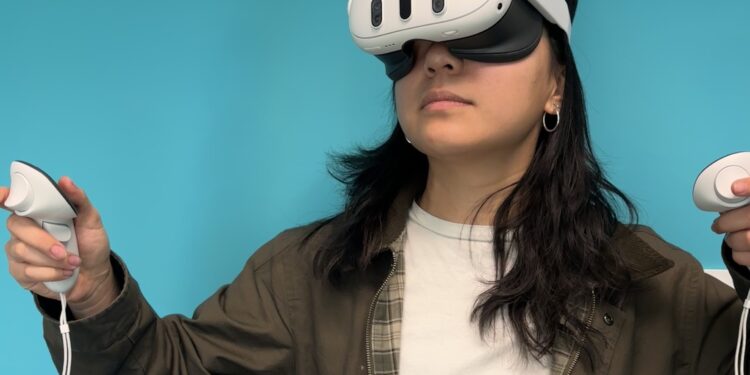Anna Fang, a graduate student from the Human-Complete Institute of Informatics of the IT school in Carnegie Mellon, uses a VR helmet to practice stress relief strategies. Credit: Carnegie Mellon University
Daily situations can sometimes look like big stressors of stress, whether it is a major work presentation, attend a party full of foreigners or to confront a partner. Talking to a friend or therapist can help. But the same goes to practice.
A new project by researchers from Carnegie Mellon University aims to facilitate this practice by studying if virtual and augmented reality (VR / AR) can simulate stressful situations and help people practice stress-relief strategies. It is a modern spin on exhibition therapy: users can put a pair of VR / AR glasses and practice what they mean with a digital audience.
The research team, led by Anna Fang, a graduate student of the Human-Computer Institute for Interaction of the IT school, will present her work at the next Conference for Computing Machinery on human factors in IT systems (CHI 2025).
The researchers tested their stress simulation technology on a group of 19 participants, the majority of whom have supported it massively.
“Over the past 10 to 20 years, virtual reality and augmented reality have taken a very large grip on the health and mental health space,” said Fang, noting the many meditation applications available for download.
However, Fang has noticed that these applications generally place users in a disinfected and isolated environment – such as a virtual forest or a beach – while they offer breathing advice and exercises to adapt, which makes it difficult to transfer these skills to the real world.
Anna Fang, a graduate student from the Human-Complete Institute of Informatics of the IT school in Carnegie Mellon, uses a VR helmet to practice stress relief strategies. Credit: Carnegie Mellon University
“The project comes from me wanting a practical way for people to learn these skills and apply them to their real life,” said Fang. “Can we use virtual and augmented reality to simulate an office environment, or a conflict with someone? Then, you can really practice some of these personal care skills in a real-life environment.”
To start, Fang and his team have focused on three scenarios that seem to cause the most stress and anxiety of their daily life, according to research, public speaking, crowded social events and interpersonal conflicts.
The team built eight prototypes with different design elements for each of the three scenarios, for a total of 24 prototypes. These prototypes have taken various forms – virtual reality, mixed or augmented reality, or a text environment without visual signals – and offered different degrees of interaction. The virtual public could answer or ask questions in a prototype, for example, or sit down silently in another. In interactive prototypes, VR or AR avatars could chat with users using the dialog box fueled by a large language model. Users can also press a controller button to access the breathing and meditation exercises if they needed it, and the instructions appeared as a superimposed context window on the stage.
“For each person, we wanted to try different conceptions and different combinations, so that users can tell us what they liked and did not like it,” said Fang. “Participants generally said it was quite realistic.”
A screenshot of the VR experience showing stress relief strategies for public speaking. Credit: Carnegie Mellon University
Overall, Fang and her team found that people liked to use technology to take more awareness of themselves. “They wanted a technology that would help them acquire self-sufficiency skills they did not feel,” she said.
Participants also noted that they preferred to be able to decide when the large language model suggested advice instead of automatically receiving these tips. They also wanted to take helmets to other places to help them immerse themselves and more comfortable with the stressful setting. For example, a participant wanted to use the helmet increased in his house, because it was there that he planned to discuss a problem with his partner. Or, to speak in public, they wanted to go to class the day before to train in front of an Avatar audience.
“We are developing it more at the moment. We are creating a complete deployable model that we can put on the App Store and that people can use at home,” said Fang.
In this next version, the team plans to upgrade the avatars to appear more realistic and include more vocal text features so that avatars can speak more naturally to users.
A screenshot of the VR experience showing stress relief strategies to interact during a party. Credit: Carnegie Mellon University
“If you think you are stressed in a situation, someone’s tone has a lot,” said Fang. “We also give the avatars more realistic facial expressions and movements. So, if they are angry with you, we can make them offend the forehead.”
The upcoming version will also offer a wider menu of personal care strategies. Although the current version mainly contains profound breathing advice, the next iteration will implement the body’s relaxation and sweeping techniques as well as Earthmoking practices – such as having people calling objects around them – to help manage anxiety or panic attacks.
“We want to use the system not only to help people acquire these skills, but also to experiment with different autoin strategies,” said Fang. “They can experiment in a virtual environment that works best and that seems to them best, depending on the context, then make an informed choice on what to implement in the real world.”
Supplied by Carnegie Mellon University
Quote: VR and ARA simulations help users practice stress management in realistic scenarios (2025, April 19) recovered on April 19, 2025
This document is subject to copyright. In addition to any fair program for private or research purposes, no part can be reproduced without written authorization. The content is provided only for information purposes.



